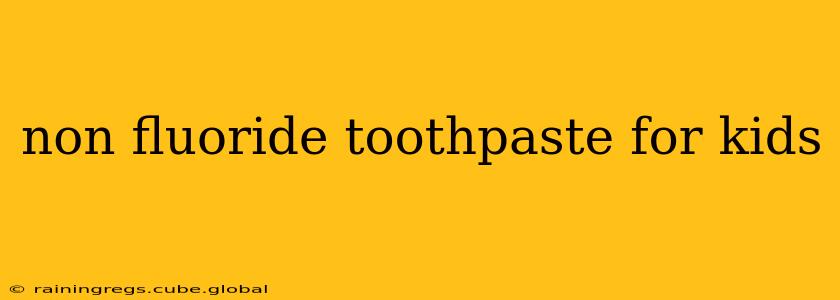Choosing the right toothpaste for your child can feel overwhelming, especially when considering fluoride. While fluoride is widely recognized for its cavity-fighting benefits, some parents opt for non-fluoride toothpaste for their children due to concerns about fluoride ingestion. This comprehensive guide will explore the reasons behind this choice, discuss the benefits and drawbacks of non-fluoride toothpaste, and answer frequently asked questions.
Why Choose Non-Fluoride Toothpaste for Kids?
Many parents choose non-fluoride toothpaste for their children due to concerns about potential fluoride toxicity. While fluoride is beneficial in preventing cavities when used topically, swallowing excessive amounts can lead to fluorosis, which can cause discoloration of the teeth. Young children, especially those under three, are more prone to swallowing toothpaste. Other parents may choose non-fluoride options due to philosophical objections to fluoride's addition to water and dental products.
What are the Benefits of Non-Fluoride Toothpaste for Kids?
The primary benefit of non-fluoride toothpaste is the reduced risk of fluoride ingestion and the subsequent possibility of fluorosis. This is particularly relevant for young children who are still learning to spit. Parents can feel more confident that their child is using a toothpaste that poses less risk of accidental ingestion. Some non-fluoride toothpastes also boast natural ingredients and are marketed as being gentler on sensitive gums.
What are the Drawbacks of Non-Fluoride Toothpaste for Kids?
The main drawback is the lack of fluoride, a crucial element in preventing cavities. While good brushing habits and regular dental checkups are essential, fluoride significantly enhances cavity prevention. Choosing a non-fluoride toothpaste means relying more heavily on these other preventative measures. The effectiveness of non-fluoride toothpaste in preventing cavities is generally lower compared to fluoride toothpaste.
Is Non-Fluoride Toothpaste Safe for Kids?
Non-fluoride toothpaste itself is generally safe for children, but its effectiveness in preventing cavities is lower than fluoride toothpaste. The safety concern is less about the toothpaste itself and more about the potential risks associated with the lack of fluoride in cavity prevention. It's crucial to understand that non-fluoride toothpastes do not provide the same level of cavity protection as fluoridated options.
How Much Toothpaste Should a Child Use?
The amount of toothpaste used depends on the child's age. For children under three, a rice grain-sized amount of toothpaste (fluoride or non-fluoride) is generally recommended. For children aged three to six, a pea-sized amount is appropriate. Always supervise your child's brushing to ensure proper technique and prevent swallowing.
When Should I Switch My Child to Fluoride Toothpaste?
Many dental professionals recommend switching to fluoride toothpaste once a child is old enough to reliably spit out the toothpaste, typically around age three. However, it's always best to consult your child's dentist for personalized advice based on their individual needs and risk factors.
What are the Best Non-Fluoride Toothpastes for Kids?
Many brands offer non-fluoride toothpaste formulated for children. Look for toothpastes specifically designed for kids, with appealing flavors and textures to encourage brushing. Always check the ingredients list to ensure it's free of harsh chemicals or artificial sweeteners. (Note: I cannot recommend specific brands here due to the evolving nature of products and the potential for bias).
Can I Use Non-Fluoride Toothpaste for My Baby?
For babies who haven't yet developed teeth, you don't need any toothpaste. Once teeth appear, you can begin using a very small amount of non-fluoride toothpaste, especially if there's a concern about fluoride ingestion. However, consult your pediatrician or dentist for personalized guidance.
Conclusion: Making Informed Choices
The decision of whether to use fluoride or non-fluoride toothpaste for your child is a personal one. Weigh the benefits and drawbacks carefully, considering your child's age, swallowing habits, and risk factors for cavities. Regular dental checkups are crucial, regardless of the type of toothpaste used. Consult your dentist or pediatrician for personalized recommendations and to ensure your child's oral health is optimal. Remember that proper brushing technique and regular dental visits remain vital components of good oral hygiene, regardless of toothpaste choice.
